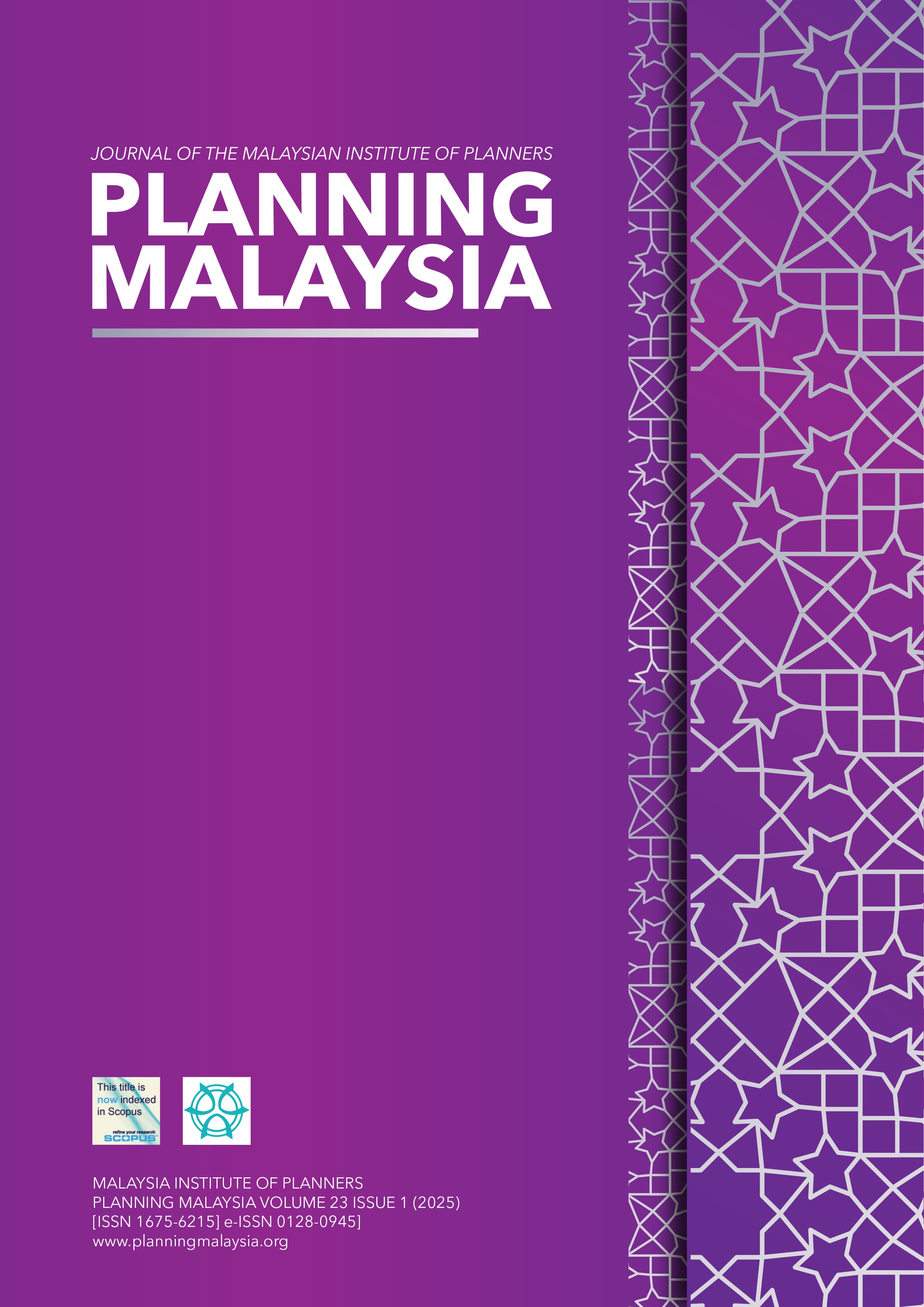ANTICIPATING LOCAL ACCEPTANCE OF SOLAR FARM DEVELOPMENT IN BATANG KALI, SELANGOR, MALAYSIA: ASSESSING POTENTIAL IMPACTS
DOI:
https://doi.org/10.21837/pm.v23i35.1663Abstract
To restructure the country's economy towards a high-value economy, the government has placed the transition to a green economy as one of the main targets of its economic restructuring efforts. This transition will create a significant positive impact on every level of society, in addition to guaranteeing the continuity of the country's energy. Nonetheless, every planned development must minimise its impacts on the communities that it will affect. The main objective of this study is to explore the impact of solar farm development on a local community in the dimension of sustainability. This study employed a quantitative research methodology to evaluate the level of impact that the community may experience. The study's primary findings revealed that the community involved in the proposed development project would be significantly affected, both positively and negatively, across social, environmental, and economic dimensions. The community anticipated that the solar renewable energy generation would have a significant positive impact, and the establishment of a solar-based community would improve the quality of life. The implications of this study will facilitate policy makers, decision makers and practitioners in developing solar farms in a sustainable manner while safeguarding the interests of local communities.
Downloads
References
Abu-Goukh, M. E., Ibraheem, G. M., & Goukh, H. M. (2013). Engineering education for sustainability and economic growth in developing countries (the Sudanese case). Procedia-Social and Behavioral Sciences, 102, 421-431. DOI: https://doi.org/10.1016/j.sbspro.2013.10.757
Bishoge, O. K., Kombe, G. G., & Mvile, N. B. (2020). Community participation in the renewable energy sector in Tanzania. International Journal of Sustainable Energy Planning and Management, 28, 121–134. https://doi.org/10.5278/Ijsepm.4477
Gupta, A. (2001). Criteria and indicators of sustainability in rural development. August, 1–424.
Hamed, T. A., & Alshare, A. (2022). Environmental impact of solar and wind energy-a review. Journal of Sustainable Development of Energy, Water and Environment Systems, 10(2), 1–23. https://doi.org/10.13044/j.sdewes.d9.0387 DOI: https://doi.org/10.13044/j.sdewes.d9.0387
Lassio, J. G., Magrini, A., & Branco, D. C. (2021). Life cycle-based sustainability indicators for electricity generation: A systematic review and a proposal for assessments in Brazil. Journal of Cleaner Production, 311, 127568. DOI: https://doi.org/10.1016/j.jclepro.2021.127568
Lennon, B., Dunphy, N. P., & Sanvicente, E. (2019). Community acceptability and the energy transition: A citizens’ perspective. Energy, Sustainability and Society, 9(1), 1-18. DOI: https://doi.org/10.1186/s13705-019-0218-z
Modotti, M., Meo, I. D., Paletto, A., & Grilli, G. (2015). Sustainability impact assessment (SIA) of renewable energy systems: Overview of indicators and needs for future developments. Forestry Ideas, 21(2), 347-357.
Mutatkar, N. (2017). Sustainability assessment of decentralised solar projects: Introducing a multi-criteria approach.
Ozili, P. K. (2022). Sustainability and sustainable development research around the world. Managing Global Transitions. DOI: https://doi.org/10.26493/1854-6935.20.259-293
PLANMalaysia, Selangor (2017). Selangor State Structure Plan 2035. https://www.planmalaysia.gov.my/documents/penerbitan_planmalaysia/rancangan-struktur/RSN_Selangor_2035.pdf
PLANMalaysia (2023). Panduan Pelaksanaan Penilaian Impak Sosial Bagi Projek Pembangunan. https://www.planmalaysia.gov.my
Roddis, P., Carver, S., Dallimer, M., Norman, P., & Ziv, G. (2018). The role of community acceptance in planning outcomes for onshore wind and solar farms: An energy justice analysis. Applied Energy, 226, 353-364. DOI: https://doi.org/10.1016/j.apenergy.2018.05.087
Sahid, M. S., Suratman, R., & Ali, H. M. (2021). Acquiring elements of solar farm development’s approval consideration in Johor. Planning Malaysia, 19. DOI: https://doi.org/10.21837/pm.v19i18.1034
Scovell, M., Mccrea, R., Walton, A., & Poruschi, L. (2024). Local acceptance of solar farms: The impact of energy narratives. Renewable and Sustainable Energy Reviews, 189(PB), 114029. https://doi.org/10.1016/j.rser.2023.114029 DOI: https://doi.org/10.1016/j.rser.2023.114029
SUSTAINABLE ENERGY DEVELOPMENT AUTHORITY (SEDA) MALAYSIA. (2021). Malaysia Renewal Energy Roadmap. http://www.seda.gov.my/
Taiwo, O. M., Samsudin, S., & Ayodele, O. M. (2021). Integration of sustainability indicators in urban formation: A gap analysis. Planning Malaysia, 19. DOI: https://doi.org/10.21837/pm.v19i18.1040
Tsoeu-Ntokoane, S., Mosabala, T. D., Kali, M., & Lemaire, X. (2024). Community imaginaries, participation and acceptance of renewable energy projects–Substituting the quicksand of development with rocky fundamentals. Cogent Social Sciences, 10(1), 2292755. DOI: https://doi.org/10.1080/23311886.2023.2292755
United Nations (2021). The high-level political forum goals energy action. Leveraging Energy Action For Advancing The Sustainable Development Goals, 223, 67–68.
Vaka, M., Walvekar, R., Rasheed, A. K., & Khalid, M. (2020). A review on Malaysia’s solar energy pathway towards carbon-neutral Malaysia beyond Covid’19 pandemic. Journal of Cleaner Production, 273, 122834. DOI: https://doi.org/10.1016/j.jclepro.2020.122834
Wanamaker, C. (2022). The environmental, economic, and social components of sustainability. Retrieved from https://soapboxie.com/Social-Issues/The-Environmental-Economic-And-Social-Components-Of-Sustainability
Yiridoe, E. K. (2014). Social acceptance of wind energy development and planning in rural communities of Australia: A consumer analysis. Energy Policy, 74, 262-270. DOI: https://doi.org/10.1016/j.enpol.2014.08.035
Downloads
Published
How to Cite
Issue
Section
License

This work is licensed under a Creative Commons Attribution-NonCommercial-NoDerivatives 3.0 Unported License.
Copyright & Creative Commons Licence
eISSN: 0128-0945 © Year. The Authors. Published for Malaysia Institute of Planners. This is an open-access article under the CC BY-NC-ND license.
The authors hold the copyright without restrictions and also retain publishing rights without restrictions.


